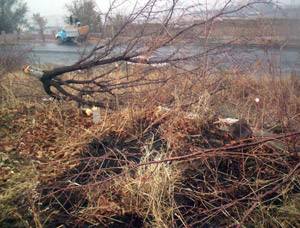According to the “Hayastan” joint stock company, during the same year, there have been 70,000 cubic meters of logging. As for the illegal logging, there have been 16,000 cubic meters. Some of the wood has been imported and we can say that the number of used wood in Armenia in 2003 was about 100,000 cubic meters. In 2004, by the decision of the government, the Swedish organization has been registered and we can assume that the rest of the 700,000 cubic meters of wood is part of the illegal logging. We can also assume that nearly that much wood is cut each year. However, owner of “Hayastan” Martun Matevosyan does not agree with the data provided by “Sida” and believes that is just a number that they made up. Mr. Matevosyan also doesn’t agree with the announcements of ecological NGOs claiming that the total percentage of forests in Armenia is 6-8%. During the Soviet era, Armenia had 11.2% of forests.
“True, many trees were cut down in the beginning of the 1990s,” says Mr. Matevosyan, “there still are illegal loggers to this day, but they came up with a wrong number. If we believe in those announcements, then we should have had 100,000 hectors of forests logged throughout these years. But it is not like that. We only have 334,000 hectors of forests. In addition, forests are naturally reproduced. It has been calculated that a one hector forest grows by 2.9 cubic meters a year. Some of the broken trees have grown again, right?’
Research was done in 1998 and it was claimed that, 260,000 hectors of forests in Armenia had high evaluations. The others had been said to be bushes and low-quality trees. According to Mr. Matevosyan’s calculations, 260,000 hectors has risen by 750,000 cubic meters of natural growth. That is why he agrees with the fact that many forests had been logged in the beginning of the 90s, even during the post-Soviet years when there was no construction going on in the forests. However, president of the “Stable Development” NGO Karine Danielyan doesn’t consider those numbers as accurate.
“During the Soviet years, until the mass loggings, our forests were like that. If they were a little lower than the average, then there was no way for self-reproduction,” says Mrs. Danielyan. “I don’t know what our authorities are thinking when they say these numbers. Some of our forests are very sparse and it is not right to consider that a hector.”
According to the owner of “Hayastan”, our natural wood is high-quality when we look at it from the production point of view. Ninety percent of the trees are oak and beech trees. This is probably why there are so many illegal but not a fixed number of loggings. Meanwhile, we import cheap and low-quality wood which is used for construction purposes. Even in the beginning of 2005, television networks were airing commercials of furniture and boards prepared by the “Golden Wood” company using local wood. According to M. Matevosyan, there are not many trees for heating methods in the forests which can satisfy Armenia’s demand for fire wood or construction wood. “ArmForest” is simply technically unequipped and there is no possibility to cross the mountains and gather the fallen down trees. The illegal loggers do their job mainly in the territories near the highway and they steal the trees on the roads with the help of the workers from the “Ecology department” and police department. The owner of “ArmForest” does not intend on blaming the forest keepers too much for the illegal loggers; there can’t be forest keepers near every forest.
“Each forest keeper can keep 1000 hectors of forest,” says M. Matevosyan. “How could he look over all that territory without any transportation, especially when they have always received a minimum salary-6000, then 13000 dram? This year, the salary will be increased to 45,000, and that is not a small amount in order to look after the forest. If he receives that amount, he will look after the forest with more care. Whereas 454,233 trees were logged illegally back in 1994, meaning 65825,3 cubic meters of wood, in 2004, 27,157 trees were logged, in other words, 10520.7 cubic meters of wood.”
The government has increased the money provided from the budget to “ArmForest” this year-one billion 137 million rams which makes up 70% of the company’s expenses. The company takes care of the rest of the expenses by the profit that they receive. More than half of the money provided by the budget-700 million drams-is used to pay the salaries. Basically, another 700 million drams is spent for looking after the forest and restoration, however, that is not enough. That is why our trees look like the trees in Sweden-straight, lean like a candle and our forests are very dirty.
In 2003, Karine Danielyan also did some research and found out that everyone is gorging the forests of Armenia-starting from the residents up to the people in control, the preservation organizations, the military and police officers, oligarchs and generals. The wood business is profitable in Armenia today, that is why most of it is shady enterprise. We can not just blame “ArmForest” and the Ministry of Agriculture for the illegal and dangerous loggings because almost everyone is of the opinion that some generals and oligarchs have divided Armenia’s forests among them are getting huge profits. We know for a fact that the authorities have not done anything to prevent this. These kinds of problems are not solved by the authorities, but rather even higher officials.
After all this, we can not keep our forests by relying on natural reproduction. Although there is no construction going on in the forests, however, there are some activities. Karine Danielyan said that she hopes this happens.
“I get happy when I hear numbers and work done during the sessions,’ says Mrs. Danielyan. “But I can’t say for sure because I have not seen anything yet.”

